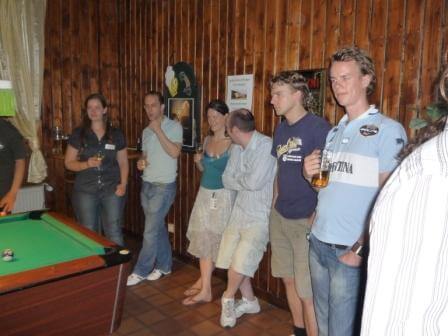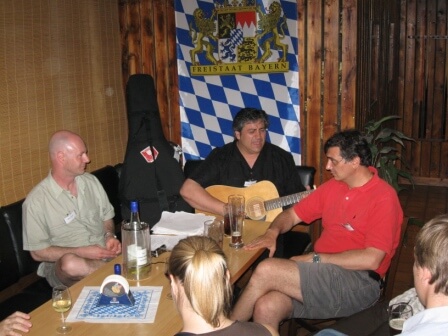The Sixth European Workshop on Celldeath

, June 1st Monday
, June 2nd Tuesday
, June 3rd Wednesday
, June 4th Thursday
, June 5th Friday
, June 6th
12:00 – 22:00 Registration
19:30 – 22:00 Welcome Reception/Dinner (Barbecue)
7:00 – 9:00 Breakfast
9:00 – 10:15 Role of IAPs in physiology and disease (Pascal Meier / Martin Leverkus)
Ueli Nachbur: A physiological role for IAPs?
Meike Broemer: Ubiquitin-mediated regulation of caspases by DIAP1
Mads Gyrd- Hansen: A conserved ubiquitin-binding domain links Inhibitor of Apoptosis Proteins to NF-kB signalling and cell survival
Martin Leverkus: The Inhibitor-of-apoptosis (IAP) protein family member XIAP is an important downstream regulator of death receptor-mediated apoptosis
Lorna Flanagan: Quantitative live cell imaging suggests a role for XIAP in regulating mitochondrial outer membrane permeabilisation (MOMP) during TRAIL-induced apoptosis
10:15 – 11:00 coffee break
11:00 – 12:30 Bcl-2 family members in apoptosis (Seamus Martin / Peter Daniel)
Grant Dewson: To trigger apoptosis Bak exposes its BH3 domain and homo-dimerizes via BH3: groove interactions
Peter T. Daniel: Role of p21, Bax and Bak in TRAIL–induced apoptosis in human carcinoma
Markus Rehm: Predictive live cell imaging elucidates the real-time kinetics of pore formation in the outer mitochondrial membrane and detects spatial waves of cytochrome-c release during apoptosis
Seamus J. Martin: Bax or Bak-induced Mitochondrial Fission can be uncoupled from Cytochrome c release and apoptosis
Marco Colombini: Mitochondria-ediated apoptosis: the role of ceramide channels
Philipp J. Jost: The role of endogenous pro-survival Bcl-2 family members in the development and sustained growth of tumours
12:30 – 14:00 lunch
14:00 – 15:30 Bcl-2 family members in apoptosis (continued)
Verena Labi: Loss of the BH3-only protein PUMA rescues mice from γ-irradiation-induced lymphomagenesis
Dana Westphal: The orf virus protein 125 is a Bcl-2–like inhibitor of apoptosis that binds BH3–only proteins but not Bax and Bak
Cristina Quintavalle: Akt modulates the half life and cellular localization of Bcl–w
Chiel Maas: Unusual cleavage of Bid is instrumental in DNA damage–induced apoptosis
Felix M. Wensveen: Deficiency of the BH3-only protein NOXA extends survival of activated lymphocytes
Franziska B. Mullauer: Betulinic Acid induces cell death in cancer cells via multiple pathways
15:30 – 16:15 coffee break
16:15 – 17:00 Sensitising Cancer Stem Cells (Jan Paul Medema / Huseyin Mehmet)
Maria Giovanna Francipane: SOCS family molecules sensitise anaplastic thyroid cancer cells to chemotherapy
Ylenia Lombardo: Bone morphogenetic protein 4 induces differentiation of colon CSCs
Louis Vermeulen: Chemoresistance in Colon Cancer Stem Cells
17:00 – 20:00 Poster Session I (presenting authors: A-L)
20:00 – 22:00 Dinner
7:00 – 9:00 Breakfast
9:00 – 10:30 Sensitising Cancer to apoptosis (Paul Ekert / Vincenzo De Laurenzi)
Michael Bots: Apaf-1 and caspase-9 are dispensable for HDACi– induced cell death of B cell lymphoma
Annelieke Jaspers: c-Abl Kinase inhibitors overcome CD40- mediated drug resistance in CLL; implications for therapeutic
targeting of chemoresistant niches
Michela Muscolini: Trichostatin A up-regulates p73 and induces Bax-dependent apoptosis in ovarian cancer cells
Simon Cook: Colorectal Cancer Cells are Addicted to Oncogene– Regulated Signalling Pathways for Repression of BIM and Growth Factor –Independent Survival
Ralph K. Lindemann: In vivo candidates screen identifies apoptotic pathways underlying HDAC inhibitor–mediated tumor therapy
Paul G. Ekert: Life and death of myeloid cells: Testing the requirements for cell death genes and transcription factors
10:30 – 11:00 coffee break
11:00 – 12:30 Sensitising Cancer to apoptosis (continued) (Ricky W. Johnstone / John Silke)
John Silke: Mechanism of apoptosis induction by IAP Antagonists
Ricky W. Johnstone: Synergistic tumor cell apoptosis mediated by vorinostat and ABT -737
Discussion I: Apoptosis therapeutics in the clinic: new impulses for basic cancer research or “much ado about nothing”? (Discussion leaders: Ricky W. Johnstone & John Silke)
12:30 – 13:45 lunch
13:45 – 15:30 Bus trip to Heidelberg
16:00 – 18:00 Visit to Heidelberg Castle
19:00 – 22:30 Dinner at Vetter`s Brewery in the Old Town of Heidelberg
22:30 – 00:30 Return by bus to Hauenstein
7:00 – 9:00 Breakfast
9:00 – 10:15 Caspases & Death domain folds (Lisa Bouchier-Hayes / Brian Ferguson)
Susan Logue: Proteomics–based identification of novel substrates for the inflammatory caspases
Maarten Hoek: Identification of proteolytic events in the membrane fraction of apoptotic cells using a quantitative proteomics approach
Brian Ferguson: AIRE and SP100 define a novel nuclear family of CARD proteins
Lisa Bouchier-Hayes: Real-time Detection of Caspase-2 Dimerization using Bimolecular Fluorescence Complementation
Claudia Manzl: Investigating the role of PIDD in DNA damageinduced apoptosis and DNA repair
10:15 – 11:00 coffee break
11:00 – 12:15 Lymphocyte-associated Death (Nigel Waterhouse / Dirk Brenner)
Nigel J. Waterhouse: Maintaining the pressure to die; cytotoxic lymphocytes trigger signalling pathways that persist although the initial stimulus is removed
Daniel Hostetter: Tipping the scales of life and death: new modes of Granzyme B-induced apoptosis
Patricia S. Hähnel: Targeting protein kinase B/AKT to reverse resistance against immune-mediated tumor suppression
Dirk Brenner: Regulation of activation-induced cell death by T cell receptor-proximal signalling
Katharina Lückerath: Analysis of knock-out/knock-in mice that express a mutant FasL lacking the intracellular domain
12:15 – 14:00 lunch
14:00 – 15:15 Alternative pathways (Cristina Munoz-Pinedo / Brent Derry)
Brent Derry: Regulation of germline apoptosis by CCM genes kri- 1/KRIT1 and C14A4.11/PDCD10 in C. elegans
Mads Daugaard: Cancer cell survival factor LEDGF/p75 is a nuclear protein that mediates lysosomal stability
Frederic Mille: The Patched dependence receptor triggers apoptosis through a caspase–activating complex
Nele Vanlangenakker: RNAi screen reveals novel kinases involved in necrotic cell death
Alfredo Caro -Maldonado: A Bax/Bak–independent apoptotic pathway induced by glucose deprivation
15:15 – 16:00 coffee break
16:00 – 17:00 Death receptor-induced apoptosis (Tobias Haas / Martin Sprick)
Aura Kaunisto: Regulation of cell death by c-Flip phosphorylation
Tobias L. Haas: Identification of novel constituents of the TNF receptor signalling complex
Inge Verbrugge: Sensitizing tumor cells to death receptorinduced apoptosis: is “stress” signalling the key?
Christina Falschlehner: Identification of novel components of the TRAIL apoptosis pathway by genome-wide RNA interference
17:00 – 20:00 Poster Session II (presenting authors: M-Z)
20:00 – 22:00 Dinner
7:00 – 9:00 Breakfast
9:00 – 10:30 Autophagy (Katja Simon / Eric Baehrecke)
Maria Høyer-Hansen: Identifying proteins in the autophagosomes by a proteomic approach
Devrim Gozuacik: Death-associated protein kinase (DAPk) is an integrator of apoptosis and autophagic cell death
Kevin M. Ryan: Identifying the factors that determine specificity in the autophagy response
Elisabetta Ferraro: Apoptosome–deficient cells lose cytochrome c through proteasomal degradation but survive by autophagydependent glycolysis
Peter Kreuzaler: Stat3, PI(3)Kinase, cathepsins and autophagy: a deadly network in mammary gland involution
Griselda Herrero-Martin: TAK1 activates AMPK and AMPKdependent cytoprotective autophagy in TRAIL-treated breast epithelial cells
10:30 – 11:00 coffee break
11:00 – 12:45 Autophagy (continued)
Monika Mortensen: The essential role of autophagy in red blood cell development
Anna Katharina Simon: Increased cell death in an autophagydeficient haematopoietic system
Eric H. Baehrecke: Genetic regulation of autophagic programmed cell death
Discussion II: Autophagy in cancer treatment: “To eat or not to eat” (Discussion leaders: Katja Simon & Eric H. Baehrecke)
12:45 – 14:30 lunch
14:30 – 17:00 2nd EWCD Football Cup (mixed)
19:00 – 21:00 Farewell Dinner (Barbecue)
21:00 – EWCD Party
7:00 – 11:00 Breakfast
Departure












